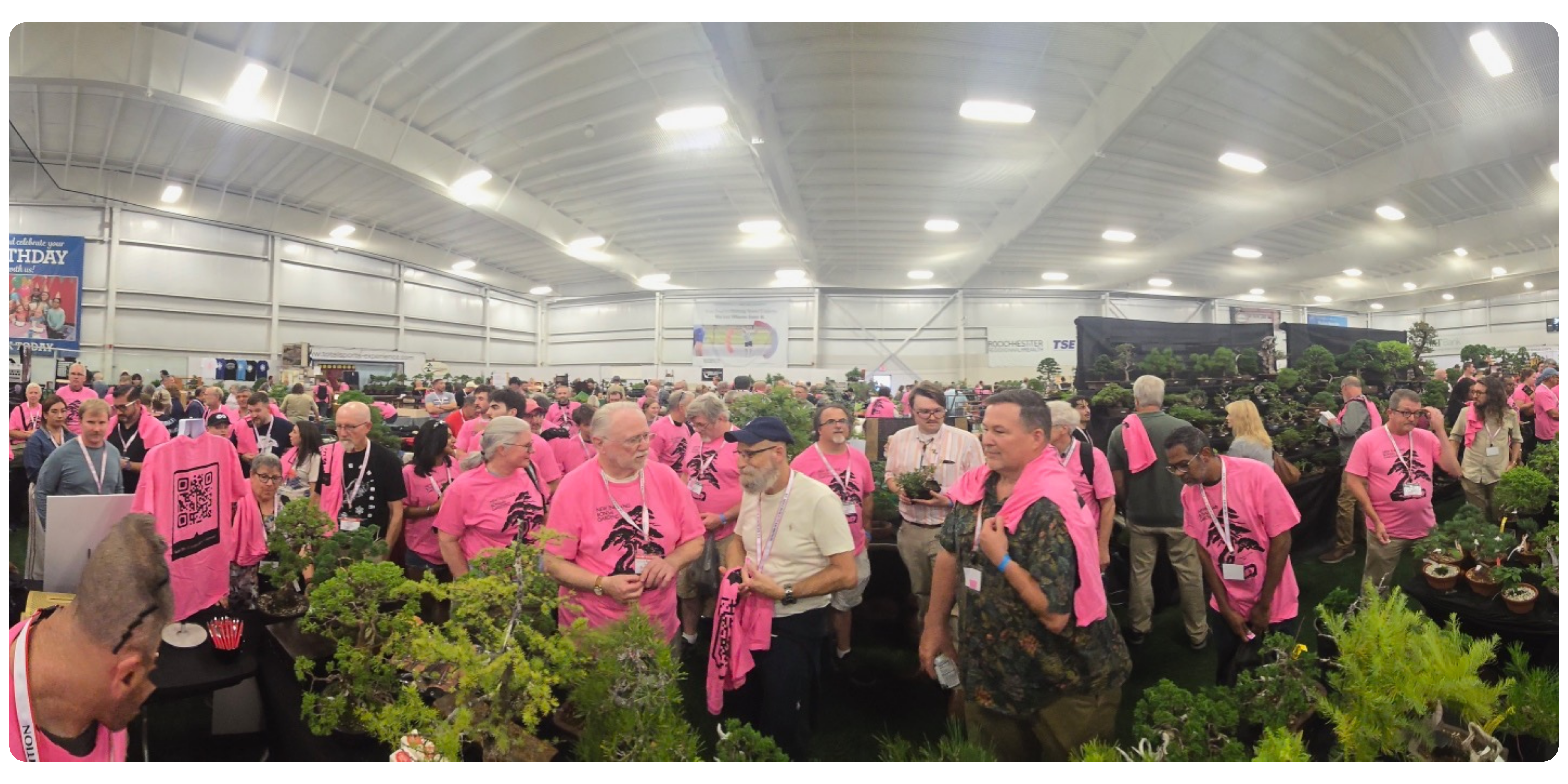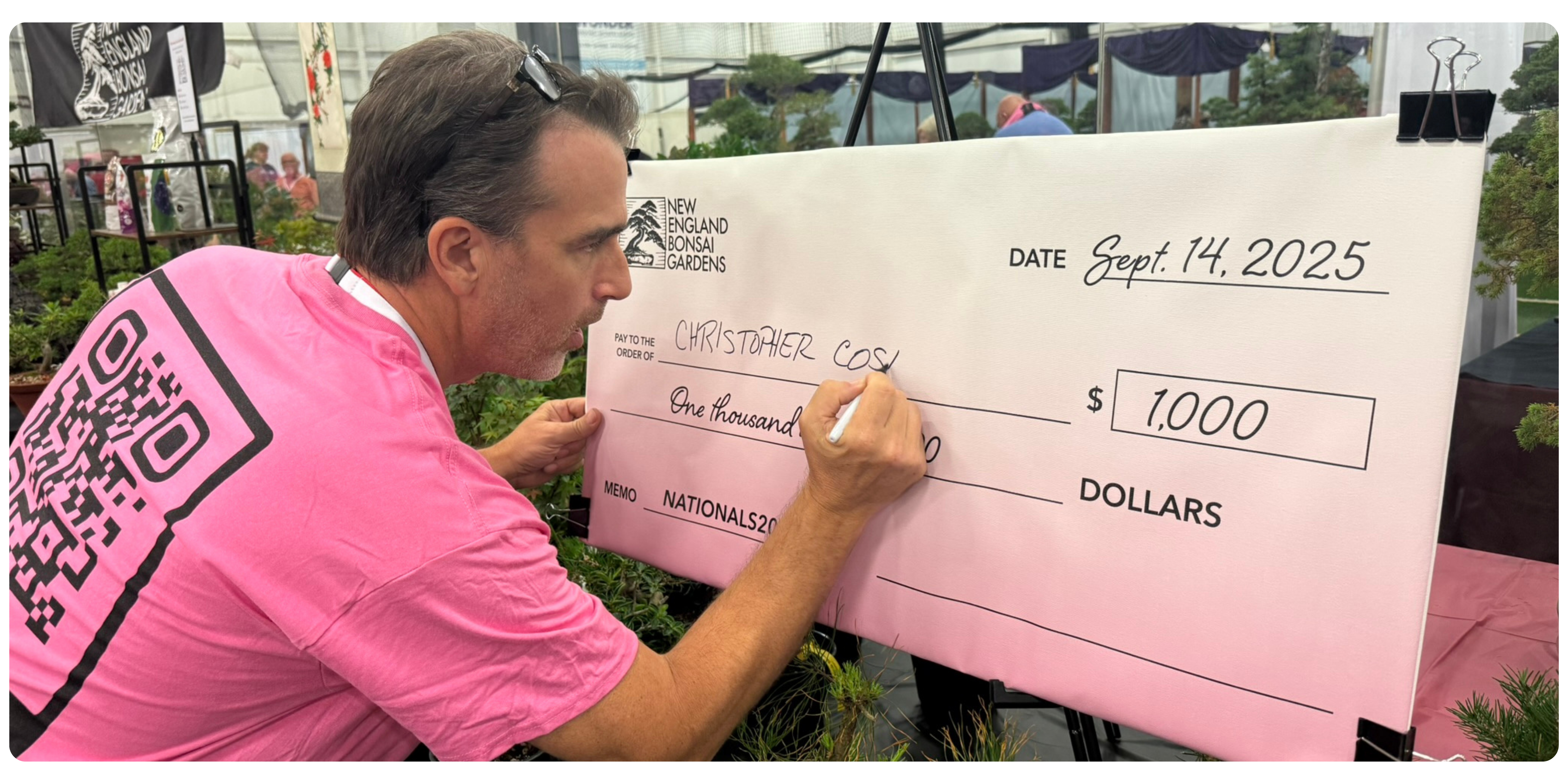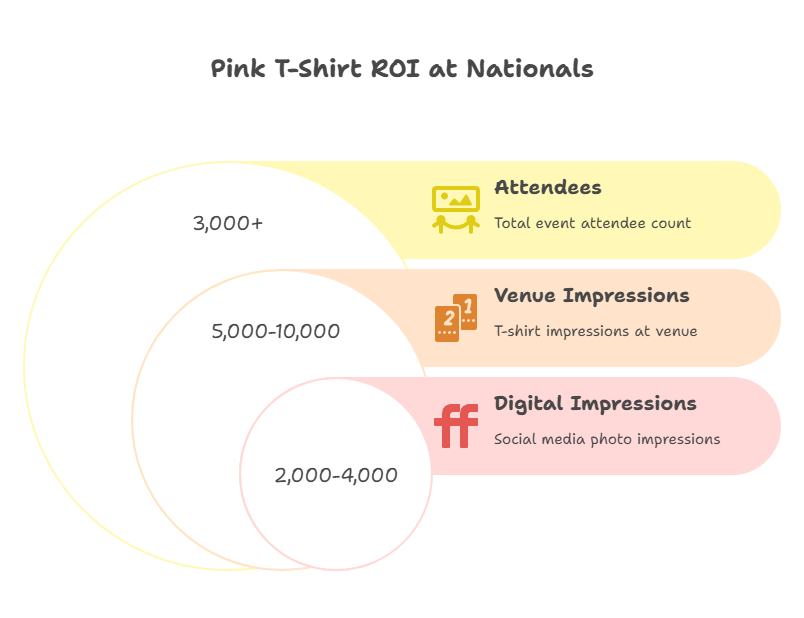The $4,000 Marketing Bet That Turned the Bonsai Nationals Pink
Posted by Ashley Carrier on Oct 8th 2025
For one weekend in Rochester, we weren’t just another vendor—we were the pink shirts.
At the U.S. Bonsai Nationals, nearly 400 attendees walked in wearing Azalea Pink NEBG T-shirts. By mid-afternoon, the hall looked like it had exploded into blossoms. Vendors were whispering about it. Event staff offered to announce it over the loudspeaker. Even outside the venue—at coffee shops and gas stations—our brand was everywhere.
That visibility didn’t happen by accident. It was the result of a $4,000 gamble, a bold color choice, and a marketing hack that turned a long waiting line into the perfect engagement channel.

The Challenge: More Than Just Showing Up
Since buying New England Bonsai Gardens in 2017, I’d attended the Nationals but never as a vendor. Vending isn’t just showing up with trees. It’s staging a brand. The booth needed to communicate quality, diversity, and community energy. With so many New Englanders attending, we weren’t just representing NEBG. We were representing home turf.
Of course I had revenue goals, but sales at the event were never the real metric. Few attendees want to carry bonsai trees onto a plane. The smarter question was: how do we turn weekend attention into long-term sales? For me, the real measurement was 90 days after the show.
The Big Idea: Branding at Scale
We brainstormed games, trivia, interactive challenges, but every idea was clunky. Where would people stand? How long before they lost interest?
Then the simplest idea stuck: T-shirts. Half joke, half vision. “Imagine if everyone here was in an NEBG shirt.” We realized it was the most scalable way to stand out.
We went bold: Azalea Pink, a color no one could miss and added incentive: a $1,000 NEBG Gift Certificate. Success wasn’t just giving away shirts; it was raising your phone above the crowd and seeing a sea of pink.
It wasn’t cheap. We spent nearly $3,000 on shirts plus the $1,000 prize. The bet was whether brand visibility and long-tail impact would outweigh the cost.
The Handout Hack: Meeting Customers Where They Are
The real breakthrough came the morning of the show. At 8 a.m., with attendees lined up around the building, Amanda said, “Let’s hand out shirts to them.”
That shift changed everything. Instead of waiting for customers to find us, we went to them. Myself, Peter, Jimmy, Jamie, and others fanned out with boxes of shirts. At first, people were skeptical. “What’s the catch?”. But once they understood the rules, the energy flipped.
By the time doors opened, nearly 400 shirts were gone.
Marketing takeaway: Remove friction. Meet customers where they already are. We turned idle wait time into the perfect engagement channel.

Read More: From Pink Shirts to Bonsai Passion – Christopher Cosenza’s Story
A Sea of Pink: Social Proof in Action
The effect was instant. Shirts were everywhere. Slung over shoulders, pulled on over sweaters, carried proudly. People sought out our booth for shirts. The crowd itself became the amplifier.
By mid-afternoon, the exhibition floor looked like azalea season. At 3:45, surrounded by a wall of pink, we pulled out the winning ticket: Chris from Tampa, Florida.
Marketing takeaway: What began as a giveaway became social proof in real time. When everyone around you wears the brand, not wearing it feels like missing out.
Beyond the Show Floor: Extending the Brand
The impact didn’t stop at the venue. That weekend, I spotted pink shirts at Tim Horton’s, at gas stations, around Rochester. The campaign had spilled into the city.
Marketing takeaway: The strongest branding isn’t confined to the event. When attendees carry your logo into everyday spaces, you gain impressions and recall without additional spend.
The ROI Question
The pink T-shirt stunt cost about $4,000. The total investment in the Nationals, once you include tree prep, trucks, trailer, hotels, meals, and travel, was closer to $7,500 (excluding opportunity cost). So how do we measure return?
Impressions
- Inside the venue: ~400 shirts in a hall of 3,000+ attendees. Each shirt was visible dozens of times throughout the day—conservatively, 5,000–10,000 impressions.
- Around Rochester: Shirts were spotted at coffee shops, restaurants, and gas stations. Add a few hundred casual exposures.
- Digital echo: Photos shared in group chats, vendor chatter, event staff mentions, and attendee social posts. Even if just 10–15% of participants posted, that’s another 2,000–4,000 impressions.

Combined, the campaign realistically generated 10,000–15,000 impressions.
- Cost per Impression (CPI): $4,000 ÷ 12,500 impressions ≈ $0.32 per impression. That beats most trade show sponsorships and even some digital ad campaigns.
- Engagement: Wearing the shirt was an opt-in endorsement. Attendees weren’t just seeing the brand; they were actively carrying it around. That’s stronger affinity than a banner or postcard.
- Long-tail effect: Every shirt worn post-show continues to generate impressions—whether it’s at a local club meeting, in someone’s backyard, or even just folded into a photo on Instagram. The ROI compounds over time.
- Post-show lift: Website traffic spiked immediately after the show, online sales ticked up, and we even got requests from people who didn’t attend but wanted a pink shirt. That tells us the buzz extended beyond attendees.
Marketing takeaway: ROI can’t be measured by weekend sales alone. The pink shirts drove visibility, affinity, and word-of-mouth that will keep paying back for months—exactly what a $7,500 investment in a national event should do.
What I’d Do Differently
- No repeat. The pink shirts worked because they were unexpected. If we did the exact same thing again, it would lose its impact. The lesson here is that marketing stunts thrive on novelty. Attendees should walk in wondering, “What will NEBG do this year?” not expecting a rerun. In 2027, we’ll need something new—different format, different hook, same goal: visibility and memorability.
- Photo ops. We missed a big opportunity by not setting up a dedicated photo moment. Imagine a pink NEBG backdrop, or a “wall of blossoms” for people to pose in front of. With hundreds of attendees already wearing shirts, we could have nudged them into creating their own user-generated content. That would have amplified our reach far beyond the venue, extended the campaign online, and given us content to reshare for weeks.
- Social integration. We leaned heavily on in-person buzz, but didn’t push attendees to share online. A simple hashtag, QR code tie-in, or incentive for posting could have extended the pink-shirt effect across platforms. Next time, building in those digital touchpoints will be key.
- Data capture balance. We dropped email collection because it slowed the handout process—but in hindsight, we could have designed a lighter, digital-first way to capture leads (QR scan + two-field form, for example). That would have given us measurable follow-up data without slowing the line.
- Content planning. The pink shirts gave us great moments, but we didn’t plan content around them. A few short videos, customer interviews in pink, or a time-lapse of the crowd turning pink would have made powerful marketing assets long after the event. Next time, we’ll build the content strategy into the stunt.
Final Thoughts
The Nationals are about more than sales. They’re about positioning, visibility, and leaving a mark. The pink shirt campaign turned our booth into a case study in experiential marketing—simple, bold, and unforgettable.
We won’t be handing out pink shirts in 2027, but we will be doing something just as disruptive.
Now I want to hear from you: What’s the boldest marketing stunt you’ve seen—or pulled off yourself—that actually worked? Drop it in the comments. Let’s trade ideas.

